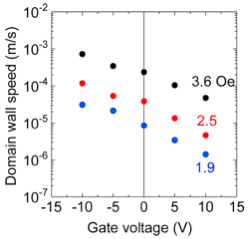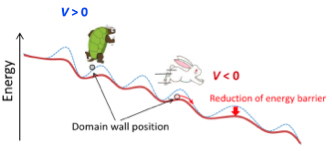Assoc Prof Chiba, D and his research group ”Significant Enhancement in Switching Speed of Magnetic Domain Wall by Voltage Application” (Published in “Nature Communications” 6 June 2012)
|
Assoc Prof Chiba, D and his research group
Significant Enhancement in Switching Speed of Magnetic Domain Wall by Voltage Application
Published in “Nature Communications“(Online Publication, June 6, 2012) |

Assoc Prof. Chiba, D.(Front Left) Mr. Shimamura, K.(Front Middle) Mr. Kawaguchi, M.(Front Right) Prof. Ono, T.(Back Left) Assoc Prof. Kobayashi, K.(Back Right). |
|
| Assoc Prof. Daichi Chiba, Mr. Masashi Kawaguchi, Mr. Kazutoshi Shimamura, Assoc Prof. Kensuke Kobayashi(presently, Prof. in Osaka University), Prof. Teruo Ono, Shunsuke Fukami (NEC/presently, Assist Prof. in Tohoku University.), and Nobuyuki Ishiwata (NEC) demonstrated that the application of the voltage can change the speed of a magnetic domain wall by more than an order of magnitude. | ||
| Controlling the displacement of a magnetic domain wall is potentially useful for information processing in magnetic non-volatile memories and logic devices. A magnetic domain wall can be moved by applying an external magnetic field and/or electric current, and its velocity depends on their magnitudes. We showed that the applying an electric field could change the velocity of a magnetic domain wall significantly. A field-effect device, consisting of a top-gate electrode, a dielectric insulator layer, and a wire-shaped ferromagnetic Co thin layer with perpendicular magnetization, was used to observe it in a finite magnetic field (Figure 1). We found that the application of the electric fields can change the magnetic domain wall velocity by more than an order of magnitude (Figure 2). This significant change is due to electrical modulation of the energy barrier for the magnetic domain wall motion (Figure 3). We think that the concept presented here will be useful in reducing the energy consumption of magnetic recording media and logic devices. | ||
 |
Figure 1. Schematic of the device structure. The device consisted of a Co microwire, an insulator layer, and a gate electrode on top. The magnetic domain wall was prepared in the wire to investigate the speed of it under applying voltage. |
|
 |
Figure 2. Applied voltage dependence of the domain wall speed. |
|
 |
Figure 3. The illustration of the potential landscape for domain wall under external magnetic field. The DW moves beyond energy barriers randomly existing in the magnetic wire by thermal activation. The direction of the DW displacement is determined by the sign of the applied external magnetic field. The application of electric field reduces energy barriers for the DW, resulting in the significant enhancement of the DW velocity. |
|
| This work was partly supported by the PRESTO program of JST, a Grant-in-Aid for Young Scientists (A) from MEXT, a Grant-in-Aid for Scientific Research (S) from JSPS, and JSPS through its ‘Funding Program for World-Leading Innovative R & D on Science and Technology’ (FIRST Program). | ||
 Institute for Chemical Research, Kyoto University
Institute for Chemical Research, Kyoto University International Joint Usage Research Center
International Joint Usage Research Center